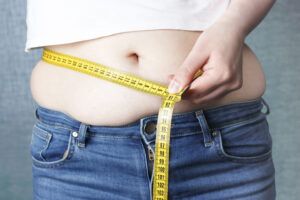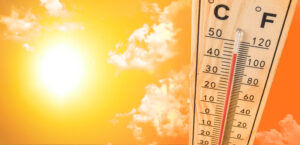1. Avoid sugar and sugar-sweetened drinks
Eating a lot of these foods with added sugar can cause weight gain.
As a matter of fact, studies show that added sugar has uniquely harmful effects on metabolic health.
Sugar, mostly due to the large amounts of fructose, can lead to fat building up around your abdomen and liver.
Sugar is comprised of half glucose and half fructose. So, when your diet includes a lot of added sugar, this overloads the liver with fructose and is forces the liver to turn it into fat.
Sugar increases abdominal fat and liver fat, which leads to insulin resistance.
Sugar in liquid form is particularly harmful, so sugary drinks should be completely eliminated from the diet.
Read the labels to make sure products do not contain refined sugars. Even foods marketed as health foods can contain significant amounts of sugar.
Remember that whole fruits do NOT need to be eliminated because they are extremely healthy and contain fiber that mitigates the negative effects of fructose.
2. Eat More Protein
Protein may be the most important macronutrient for weight loss.
Increased protein in the diet can reduce cravings by 60%, boost metabolism by 80–100 calories per day, and help you eat up to 441 fewer calories per day.
If weight loss is your goal, adding protein may be the single most effective change you can make to your diet.
Protein can not only aid in weight loss, but it may also help you to avoid regaining weight and may be particularly effective in reducing abdominal fat.
Studies showed that protein helps with weight loss when people got 25-30% of their calories from protein. So I recommend aiming for that amount of protein if you want to lose belly fat.
High protein foods include whole eggs, fish, legumes, nuts, meat, and dairy products. These are the best protein sources for your diet.
When following a vegetarian or vegan diet there are many plant based foods that are high in protein including soy, tempeh, nuts and beans.
If you struggle with getting enough protein in your diet, a quality protein powder is a healthy and convenient way to boost your total intake.
3. Eat fewer carbohydrates
Eating fewer carbs is a very effective way to lose fat.
Low carb diets also lead to quick reductions in water weight, which provides fast results. People often see a difference on the scale within 1–2 days.
Studies comparing low carb and low fat diets indicate that low carb eating specifically reduces fat in the abdomen and around the organs and liver which is the most harmful type of fat.
Reducing your carb intake to 50 grams per day causes quick weight loss. A carb intake this low puts your body into ketosis, a state in which your body starts burning fats as its main fuel and appetite is reduced.
4. Eat fiber-rich foods
Dietary fiber is mostly indigestible plant matter. Increasing fiber in the diet slows the movement of food through your digestive tract and therefore causes reduced appetite and prolonged feeling of fullness.
One review study found that an additional 14 grams of fiber per day were linked to a 10% decrease in calorie intake and weight loss of around 4.5 pounds (2 kg) over 4 months.
One 5-year study reported that eating 10 grams of soluble fiber per day was linked to a 3.7% reduction in the amount of fat in the abdominal cavity.
The best source of fiber is to eat a lot of plant foods, including vegetables and fruit. Legumes are also a good source, as well as some cereals, such as whole oats.
If you want to add a fiber supplement, Glucomannan is one of the most viscous dietary fibers, and studies suggest it can help with weight loss.
5. Exercise regularly
One of the great benefits of regular exercise is that it helps to reduce abdominal fat.
I don’t mean doing abdominal exercises, as spot reduction, losing fat in one spot is not possible.
Weight training and cardiovascular exercise will reduce fat across the body.
Aerobic exercise, like walking, running, and swimming, can reduce abdominal fat.
Exercise also leads to reduced inflammation, lower blood sugar levels and helps correct other metabolic problems that are associated with excess abdominal fat.
6. Track your food intake
Tracking food intake doesn’t mean you need to weigh and measure everything you eat.
Tracking intake every now and then for a few days in a row can help you realize the most important areas for change.
Planning ahead can help you achieve specific goals, such as boosting your protein intake to 25–30% of calories or cutting down on unhealthy carbs.
There are many free apps available to help you count calories or count carbohydrates.
Types of belly fat
Stress Belly: fat deposited mostly around the navel and is hard to the touch.
1. Better Sleep Hygiene. To help correct stress belly, it is important to work on better sleep hygiene:
- Go to bed and wake up at the same time every day, even on weekends.
- Be Mindful. Shortly before bedtime, try a relaxation strategy that incorporates mindfulness, deep breathing, or meditation, all of which boost sleep time and quality.
- Turn Screens Off Early. The blue light emitted by digital devices—including TVs, phones, laptops, and tablets—can throw off your body’s internal clock, so avoid them before bedtime. Finding a tech-free way to wind down can help soothe stress.
- Take a Hot Bath or Shower to Relax. Going from warm water into a cooler bedroom will cause your body temperature to drop, naturally making you feel sleepy.
- Count Sheep. This works because keeping your brain focused on one thing helps you power down. Counting backwards from 100 is another option. You can also try focusing on your breathing, consciously taking deep breaths in and out, until you feel calmer.
- Avoid caffeine, alcohol, large meals, foods that induce heartburn, and drinking a lot of fluid for several hours before bedtime.
- Exercise Regularly. Exercise is a great stress reliever and has been shown to improve the quality of sleep, particularly for people with insomnia. But make sure your more intense workouts aren’t too close to bedtime. Try to get your workouts in at least three hours before you turn in.
- Try Worrying Earlier in the Day. When your mind is racing with concerns while you’re trying to fall asleep, that can make it nearly impossible to drift off. Plan for 15 minutes during the day to process these thoughts. Writing a to-do list or thinking about solutions can be a healthy way to deal with stress and prevent it from interfering with sleep later.
- Have an herbal tea. Chamomile and other herbal teas can help relax and sooth the body, which can make it easier to fall asleep. Try pairing it with a good book and making it a mini-routine to end your night.
- If you are having trouble falling asleep after 20 minutes of turning off the lights (or if you wake up and can’t fall back to sleep in 20 minutes), get out of bed and do something relaxing until you feel sleepy – like that cup of tea and a book.
2. Change your workout routine. If you are doing high intensity exercise and have a stress belly, change your routine to something like Yoga, Pilates or going on walks.
3. Decrease the amount of caffeine you are drinking.
Hormonal belly: soft fat on the sides of your abdomen
This is largely due to a sedentary lifestyle and eating too much sugar and or drinking too much alcohol. This is the type of belly that many menopausal women report having. Hormonal imbalances in menopause and peri menopause can cause the hormonal belly. In addition to working to achieve hormone balance through hormone replacement, you can help correct this belly fat by:
- Reducing or eliminating refined carbs like cookies, cakes, candy and white bread or food items with too much starch like pasta and rice.
- Increasing lean protein, vegetables and good fats in your diet.
- Making aerobic and weight resistance exercise part of your regular routine.
Mommy belly: fat over the entire belly.
Working on improving sleep hygiene, increase water intake, increase amounts of healthy fats in your diet. Also, ask your provider to evaluate you for possible Diastasis recti or there are videos available on YouTube.com that will show you how to check for this separation of the abdominal muscles.
Bloated belly: belly pooches out, rather than having fat deposits.
Eliminate inflammatory foods (gluten, egg, soy, dairy are the most common offenders), take a probiotic, eat mostly fresh vegetables, meat, chicken and fish, avoid breads and pastries.
Low belly: fat is mainly in the lower part of the belly.
This could be due to having a diet with very little variety and working out more intensely than is necessary. Again, this type belly can be due to Diastasis recti.
The way to get rid of the low belly is through eating a healthy, fiber-rich diet and drinking ample amounts of water. Include green leafy vegetables and whole grains in your diet. If you do a lot of squats in your exercise routine, decrease the number of squats and do more planks instead. It is important to work all your muscles instead of focusing on one.




